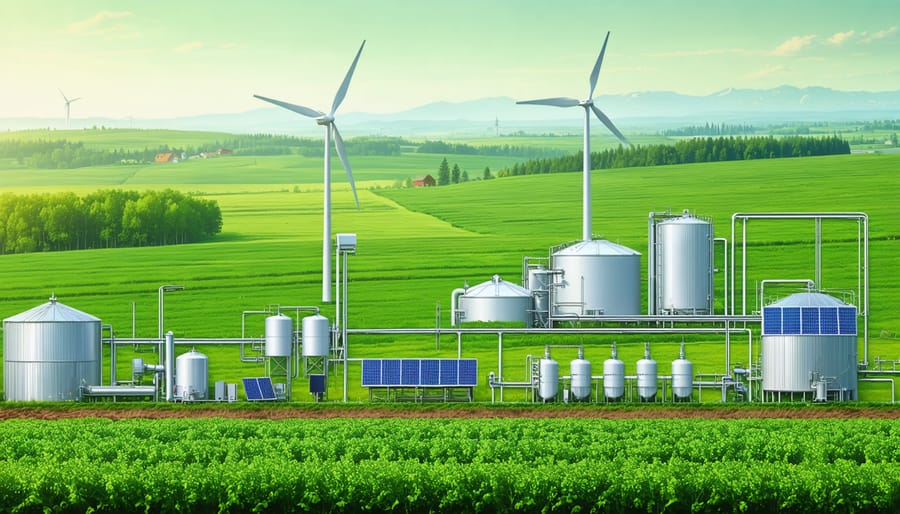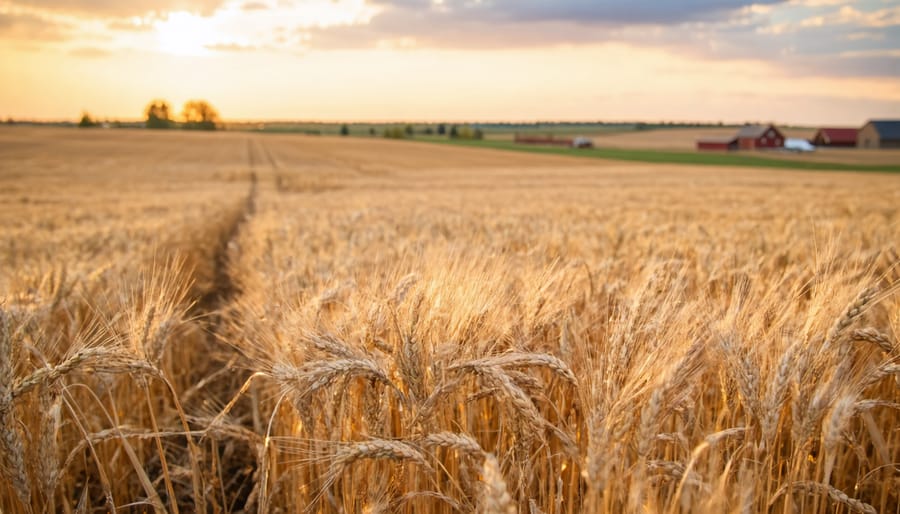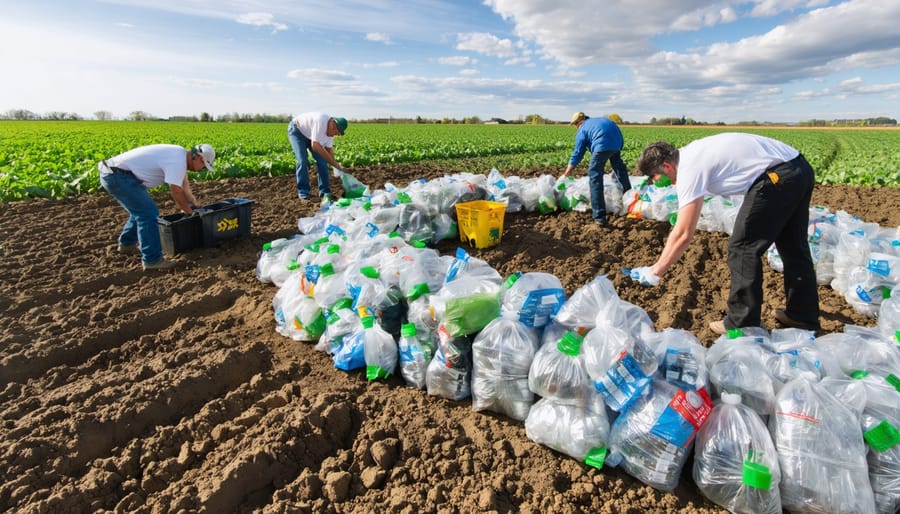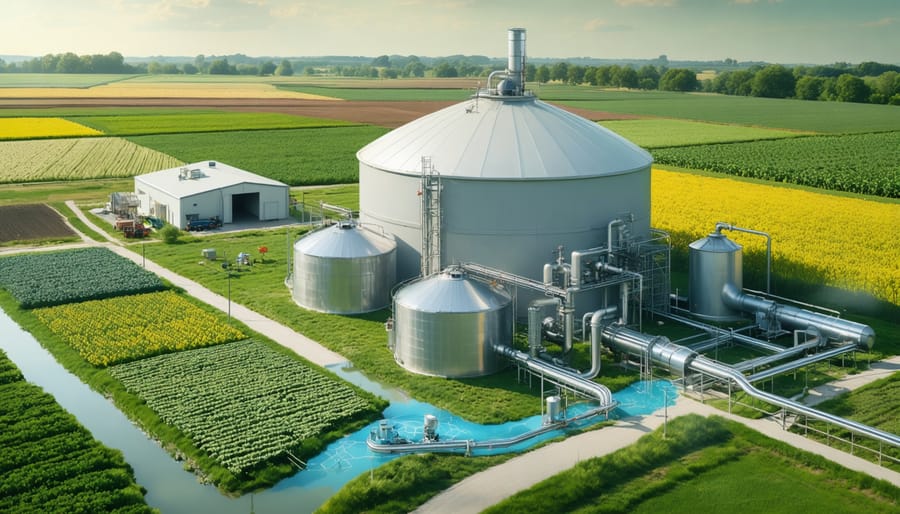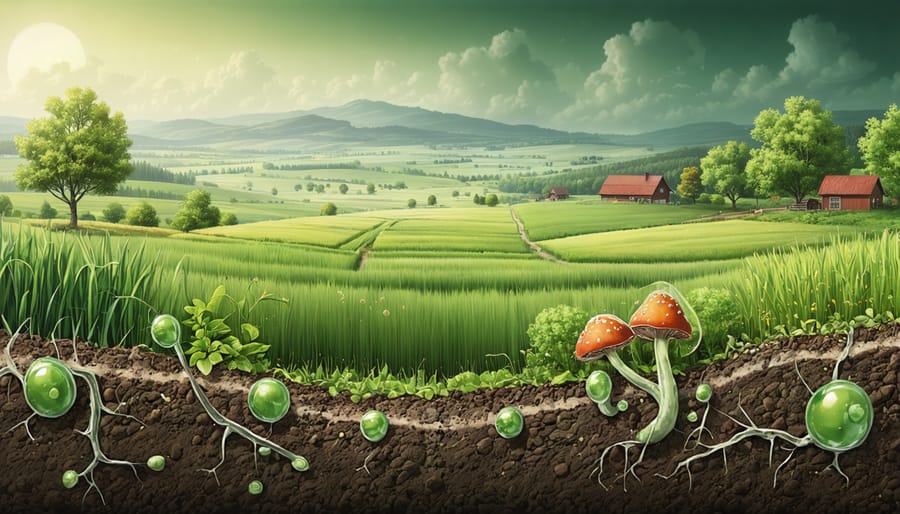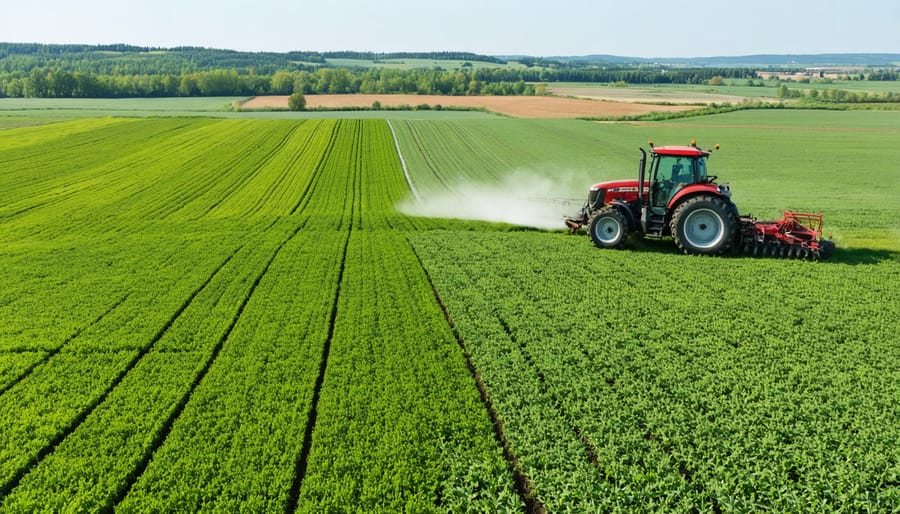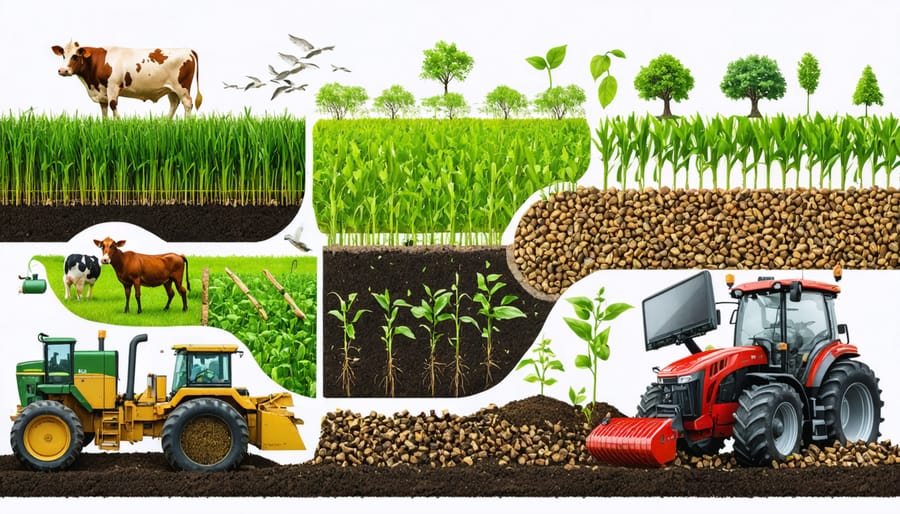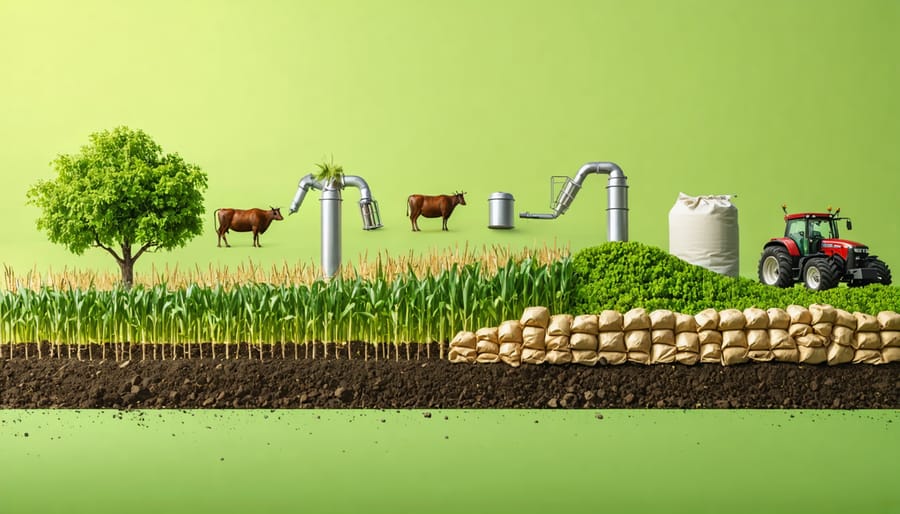Transform agricultural waste into valuable energy resources across Alberta’s farming communities, where innovative waste-to-energy projects already generate millions in revenue while reducing environmental impact. Local farmers are converting everything from livestock manure to crop residues into biogas, powering their operations and feeding excess energy back into the provincial grid. The Lethbridge Biogas facility alone processes over 120,000 tonnes of organic waste annually, demonstrating how agricultural waste can become a sustainable power source while creating new income streams for farmers.
Canadian farms are uniquely positioned to lead North America’s waste-to-energy revolution, with our abundant organic resources and established infrastructure for renewable energy projects. Whether through anaerobic digestion of manure, gasification of crop residues, or converting food processing waste into biofuel, these technologies offer practical solutions for waste management while advancing Canada’s clean energy goals. This article explores real-world examples from Alberta farms that have successfully implemented waste-to-energy systems, providing both the environmental and economic benefits that make these projects increasingly attractive to the agricultural sector.
Biogas Success: The Thompson Family Dairy Operation
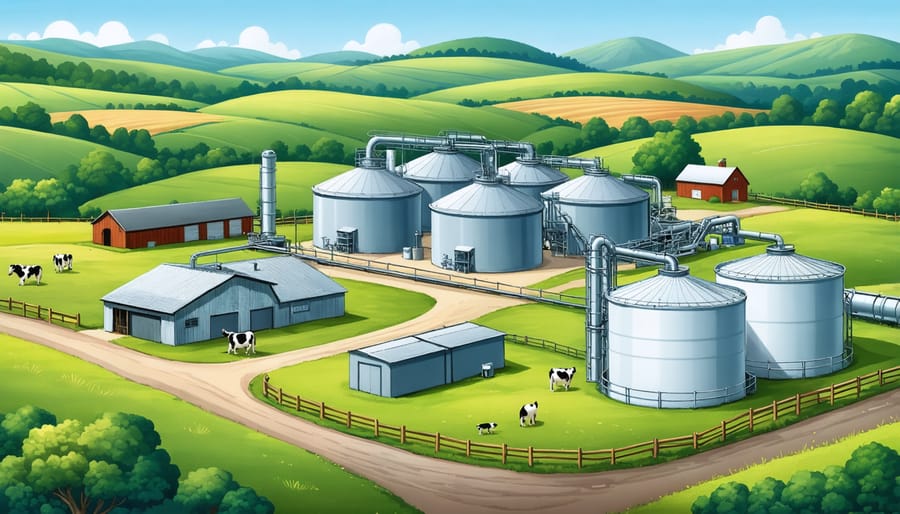
From Manure to Money
At the Stoneridge Farm in Olds, Alberta, what started as a manure management challenge has transformed into a profitable venture through biogas production from farm waste. The Johnston family installed a 250-kilowatt biogas system in 2019, processing daily manure from their 200-head dairy operation alongside crop residues.
The system consists of two main components: a primary digester where organic matter breaks down, and a secondary storage tank that captures additional biogas. The farm now processes 25 tonnes of organic waste daily, generating enough electricity to power 200 homes while producing nutrient-rich fertilizer as a valuable by-product.
The initial investment of $1.2 million was offset by provincial grants and energy efficiency programs. Within 18 months, the farm reduced its electricity costs by 85% and created a new revenue stream by selling excess power back to the grid. The system generates approximately $120,000 in annual revenue through electricity sales and carbon credits.
Beyond financial benefits, the Johnstons report improved soil health from using digested manure and a significant reduction in odour complaints from neighbouring properties. Their success has inspired five other Alberta farms to implement similar systems, creating a growing network of waste-to-energy producers in the region.
Environmental Impact and Community Benefits
The implementation of waste-to-energy systems on Alberta farms has shown remarkable environmental benefits while strengthening local communities. Recent studies from the University of Alberta demonstrate that farms using biodigesters reduce their greenhouse gas emissions by up to 85% compared to traditional waste management methods. This significant reduction helps our agricultural sector move closer to Canada’s emissions reduction targets.
In Lacombe County, farmer Jim Peterson’s biodigester system not only processes his dairy farm’s waste but also supplies enough electricity to power 50 nearby homes. “We’re turning what was once a disposal challenge into a community asset,” Peterson explains. “Our neighbours appreciate having a reliable, local energy source.”
Beyond emissions reduction, these systems help improve local air quality by capturing methane that would otherwise be released into the atmosphere. The processed waste produces high-quality fertilizer, reducing the need for synthetic alternatives and creating a valuable secondary revenue stream for farmers.
Many communities report additional benefits, including reduced odour from farm operations and decreased pressure on municipal waste management systems. The Mountain View County Agricultural Services Board found that farms with waste-to-energy systems experienced a 40% reduction in waste management costs while building stronger relationships with their non-farming neighbours through shared energy initiatives.
These outcomes demonstrate how waste-to-energy projects can create win-win situations for both agricultural operations and their surrounding communities.
Crop Residue Revolution: Prairie Biomass Solutions
Straw to Power: The Wilson Farm Story
Located just outside of Red Deer, Alberta, the Wilson family farm has transformed their agricultural waste management approach into a sustainable energy success story. In 2018, Tom and Sarah Wilson began exploring ways to utilize the 2,000 tonnes of wheat straw their 1,200-hectare farm produced annually.
Working with local agricultural engineers, the Wilsons installed a biomass conversion system that processes their excess straw into energy. The system uses a combination of anaerobic digestion and thermal conversion to generate both electricity and heat for their farm operations.
“We used to burn our excess straw in the fields,” explains Tom Wilson. “Now it powers our grain drying facilities and heats our greenhouse operations throughout the winter months.” The system generates approximately 150 kilowatts of electricity daily, enough to power their entire farm operation and sell surplus energy back to the grid.
The initial investment of $425,000 was offset by provincial green energy grants and is expected to pay for itself within six years through reduced energy costs and revenue from power sales. The Wilsons report annual savings of $45,000 on energy costs alone.
Beyond the financial benefits, the system has reduced their farm’s carbon footprint by approximately 85 tonnes annually. The process also produces biochar as a by-product, which the Wilsons incorporate into their soil to improve fertility and water retention.
“The best part is knowing we’re contributing to both environmental sustainability and the farm’s bottom line,” says Sarah Wilson. Their success has inspired five neighbouring farms to implement similar systems, creating a growing community of sustainable energy producers in central Alberta.
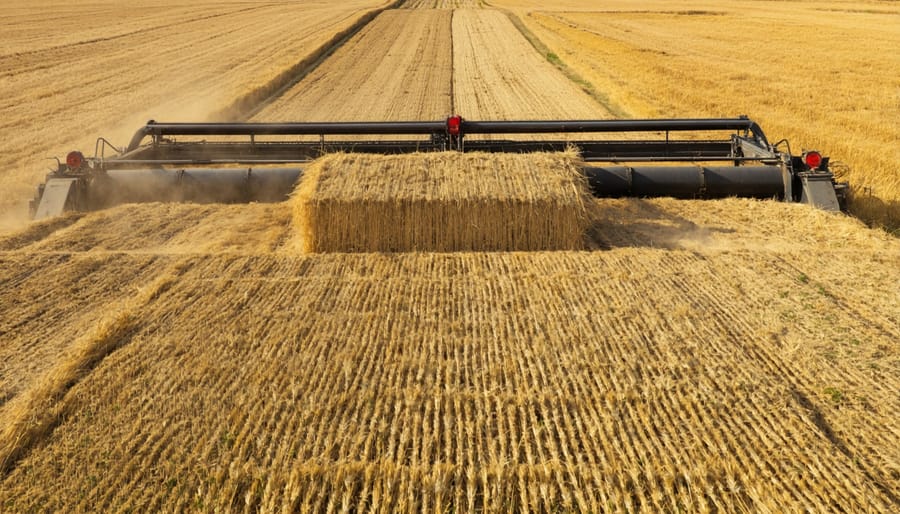
Making it Work: Equipment and Process
Setting up a waste-to-energy system requires careful planning and the right equipment selection. For most Alberta farms implementing circular agricultural practices, an anaerobic digester serves as the cornerstone equipment. These systems typically include a pre-treatment unit, digestion chamber, and biogas collection system.
The process begins with waste collection and sorting. Organic materials like manure, crop residues, and food processing waste are gathered and processed to ensure proper particle size. A properly sized digester for a mid-sized dairy operation (150-200 head) typically requires a 400-cubic-metre chamber.
Key equipment components include:
– Material handling system
– Temperature control units
– Gas storage tank
– Generator set
– Monitoring equipment
The digestion process takes 20-30 days under mesophilic conditions (35-40°C). Regular maintenance checks are essential, particularly during winter months. Many Alberta farmers have found success by starting small and scaling up gradually, allowing them to learn the system’s nuances without overwhelming their operations.
Local equipment suppliers can help with initial setup, and many offer ongoing support services. Several agricultural extension programs provide training for system operation and maintenance, ensuring farmers can troubleshoot common issues independently.
Remember to factor in seasonal variations when planning your system capacity, as waste volume and composition can change significantly throughout the year.
Small-Scale Solutions That Work
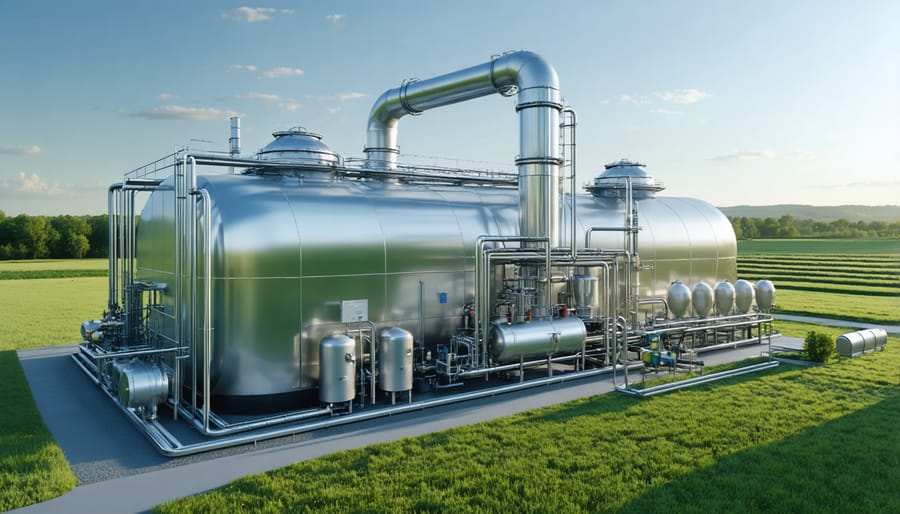
On-Farm Digesters
On-farm digesters are becoming increasingly popular across Alberta’s agricultural landscape, offering farmers a practical solution for managing organic waste while generating renewable energy. These small-scale biogas systems convert manure, crop residues, and other organic materials into methane-rich biogas that can power farm operations.
Take the Morrison Farm near Red Deer, for instance. Their 250-cattle operation installed a modular digester system in 2019, processing roughly 30 tonnes of manure daily. The system now generates enough electricity to power their entire dairy operation and provides surplus heat for their greenhouse operations during winter months.
The beauty of on-farm digesters lies in their scalability. Systems can be sized to match individual farm needs, from small operations processing 10 tonnes per day to larger setups handling 50 tonnes or more. Most Alberta farmers find that medium-sized systems, processing 20-30 tonnes daily, offer the best balance of investment and returns.
Beyond energy production, these systems create valuable by-products. The digested material makes an excellent fertilizer, reducing the need for chemical alternatives. Local agricultural extension services report that farms using digesters typically save 15-20% on fertilizer costs annually.
Getting started with an on-farm digester requires careful planning. The Alberta Agricultural Department offers technical support and funding programs to help farmers assess feasibility and implement these systems. Many successful installations begin with a free consultation through local agricultural offices.
Composting with Heat Recovery
In Alberta’s challenging climate, innovative farmers are discovering that proven composting systems can do more than just create valuable soil amendments – they can also generate significant heat energy. The process, known as thermophilic composting, naturally produces temperatures between 55-65°C, which savvy producers are now harnessing for various farm applications.
Take the case of Mountain View Farms near Red Deer, where operator Sarah Thompson installed a heat recovery system in her composting facility. Using a network of pipes embedded in her compost windrows, she captures thermal energy to heat her greenhouse throughout winter, saving approximately $3,000 in annual heating costs.
The system works by circulating water through the pipes, which absorb heat from the decomposing organic matter. This heated water is then used directly for radiant floor heating or run through a heat exchanger for other applications. Most impressive is that these systems can maintain consistent temperatures even during Alberta’s coldest months.
What makes this approach particularly attractive is its dual benefit: farmers get high-quality compost while reducing their heating expenses. The initial setup costs typically range from $5,000 to $15,000, but with current energy prices, most systems pay for themselves within 3-5 years through reduced heating costs and improved soil fertility.
Getting Started: Practical Steps
Assessment and Planning
Before implementing waste-to-profit technologies, conducting a thorough assessment of your farm’s potential is crucial. Start by documenting your current waste streams, including crop residues, animal manure, and organic processing waste. Calculate monthly and seasonal volumes to understand your resource availability.
Next, evaluate your energy needs by reviewing utility bills and identifying peak usage periods. Consider both electrical and heating requirements across different farm operations. This data will help determine the most suitable waste-to-energy solution for your farm.
Create a detailed implementation plan that includes:
– Infrastructure requirements and available space
– Initial investment costs and potential funding sources
– Required permits and regulatory compliance
– Timeline for installation and operational startup
– Training needs for staff
– Maintenance schedule and responsibilities
Connect with local agricultural extension services and experienced farmers who have implemented similar systems. They can provide valuable insights and help avoid common pitfalls. Consider starting with a smaller pilot project to test effectiveness and scalability before full implementation.
Remember to factor in seasonal variations in waste production and energy demand when planning your system’s capacity. This ensures optimal performance year-round and maximizes return on investment.
Available Support and Resources
For Alberta farmers interested in implementing waste-to-energy projects, there’s a robust network of support and resources available. The Agricultural Research and Extension Council of Alberta (ARECA) offers technical guidance and connects farmers with local experts who can assess project feasibility and provide implementation support.
The Canadian Agricultural Partnership (CAP) provides grants of up to $250,000 for sustainable agriculture initiatives, including waste-to-energy projects. These funds can cover up to 50% of eligible project costs, making the initial investment more manageable for farm operations of any size.
Local agricultural fieldmen and environmental specialists through Alberta Agriculture and Forestry are available for free consultations and can help navigate permit requirements and environmental assessments. The Alberta Farmers’ Association hosts regular workshops and field days where farmers can learn from peers who have successfully implemented waste-to-energy systems.
For technical expertise, the Southern Alberta Institute of Technology (SAIT) offers specialized training programs and consulting services. Their Green Building Technologies lab can provide detailed analysis of potential energy yields and system specifications tailored to your farm’s needs.
The Environmental Stewardship and Climate Change Producer Program specifically supports farmers transitioning to renewable energy solutions, offering both financial and technical assistance throughout the project lifecycle.
As we’ve explored throughout this article, waste-to-energy solutions offer tremendous potential for Alberta’s farming community. From dairy farms generating biogas from manure to crop producers converting agricultural residues into valuable energy sources, these innovations are reshaping our agricultural landscape while contributing to a more sustainable future.
The success stories we’ve shared from local farmers demonstrate that waste-to-energy projects are not just environmentally sound but also economically viable. By implementing these solutions, you can reduce operational costs, create additional revenue streams, and contribute to Canada’s renewable energy goals.
Remember, you don’t have to tackle these projects alone. Alberta’s agricultural community is known for its collaborative spirit, and there are numerous resources, grants, and expert consultants available to help you get started. Whether you’re considering a small-scale biodigester or a larger biomass facility, taking the first step toward waste-to-energy conversion could transform your farm’s sustainability profile.
We encourage you to reach out to local agricultural extension offices, connect with featured farmers, and explore available funding opportunities. By working together, we can turn agricultural waste into valuable energy resources while building a more resilient farming future for Alberta.
The transition to waste-to-energy systems may seem challenging, but the long-term benefits for your farm, community, and environment make it a worthwhile investment. Start small, learn from others’ experiences, and become part of Alberta’s growing sustainable agriculture movement.

